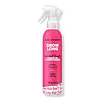What's inside
What's inside
 Key Ingredients
Key Ingredients

 Benefits
Benefits

 Concerns
Concerns

 Ingredients Side-by-side
Ingredients Side-by-side

Water
Skin ConditioningCetyl Alcohol
EmollientBehentrimonium Chloride
PreservativeParfum
MaskingPhenoxyethanol
PreservativeCaffeine
Skin ConditioningTocopheryl Acetate
AntioxidantPanax Ginseng Root Extract
EmollientBiotin
AntiseborrhoeicCocos Nucifera Oil
MaskingStearyl Alcohol
EmollientPropylene Glycol
HumectantCyclopentasiloxane
EmollientDivinyldimethicone/Dimethicone Copolymer
Isopropyl Alcohol
SolventAmodimethicone
Ethylhexylglycerin
Skin ConditioningC12-13 Pareth-3
EmulsifyingCetrimonium Chloride
AntimicrobialTrideceth-12
EmulsifyingC12-13 Pareth-23
CleansingButylene Glycol
HumectantSodium Hydroxide
BufferingWater, Cetyl Alcohol, Behentrimonium Chloride, Parfum, Phenoxyethanol, Caffeine, Tocopheryl Acetate, Panax Ginseng Root Extract, Biotin, Cocos Nucifera Oil, Stearyl Alcohol, Propylene Glycol, Cyclopentasiloxane, Divinyldimethicone/Dimethicone Copolymer, Isopropyl Alcohol, Amodimethicone, Ethylhexylglycerin, C12-13 Pareth-3, Cetrimonium Chloride, Trideceth-12, C12-13 Pareth-23, Butylene Glycol, Sodium Hydroxide
Water
Skin ConditioningTriheptanoin
Skin ConditioningC13-16 Isoparaffin
SolventHydrolyzed Cottonseed Protein
Skin ConditioningHydrolyzed Quinoa
Skin ConditioningHydrolyzed Soy Protein
HumectantBertholletia Excelsa Seed Oil
EmollientTheobroma Grandiflorum Seed Butter
Skin ConditioningNymphaea Caerulea Flower Extract
Skin ConditioningHelianthus Annuus Seed Extract
Skin ConditioningRosmarinus Officinalis Leaf Extract
AntimicrobialEquisetum Arvense Extract
AstringentLoeselia Mexicana Leaf Extract
Arnica Montana Flower Extract
MaskingCalycophyllum Spruceanum Bark Extract
Skin ConditioningMalachite Extract
AntioxidantSimmondsia Chinensis Seed Oil
EmollientPhenoxyethanol
PreservativePolyquaternium-6
Polysorbate 20
EmulsifyingAminopropyl Phenyl Trimethicone
Skin ConditioningPhenyl Trimethicone
Skin ConditioningPEG-12 Dimethicone
Skin ConditioningParfum
MaskingPolyquaternium-16
Ethylhexyl Methoxycinnamate
UV AbsorberPPG-26-Buteth-26
Skin ConditioningCitric Acid
BufferingPanthenol
Skin ConditioningPEG-12 Allyl Ether
Amodimethicone
PEG-40 Hydrogenated Castor Oil
EmulsifyingBenzophenone-4
UV AbsorberHexyl Cinnamal
PerfumingEthylhexyl Salicylate
UV AbsorberPEG-12
HumectantButyl Methoxydibenzoylmethane
UV AbsorberTetrasodium EDTA
Limonene
PerfumingBenzyl Salicylate
PerfumingLinalool
PerfumingGlycerin
HumectantCetrimonium Chloride
AntimicrobialTrideceth-12
EmulsifyingCitronellol
PerfumingBenzyl Alcohol
PerfumingEugenol
PerfumingPropylparaben
PreservativeCI 42090
Cosmetic ColorantButylparaben
MaskingEthylparaben
PreservativeMethylparaben
PreservativePropylene Glycol
HumectantButylene Glycol
HumectantSodium Benzoate
MaskingPotassium Sorbate
PreservativeDisodium EDTA
1,2-Hexanediol
Skin ConditioningCaprylyl Glycol
EmollientWater, Triheptanoin, C13-16 Isoparaffin, Hydrolyzed Cottonseed Protein, Hydrolyzed Quinoa, Hydrolyzed Soy Protein, Bertholletia Excelsa Seed Oil, Theobroma Grandiflorum Seed Butter, Nymphaea Caerulea Flower Extract, Helianthus Annuus Seed Extract, Rosmarinus Officinalis Leaf Extract, Equisetum Arvense Extract, Loeselia Mexicana Leaf Extract, Arnica Montana Flower Extract, Calycophyllum Spruceanum Bark Extract, Malachite Extract, Simmondsia Chinensis Seed Oil, Phenoxyethanol, Polyquaternium-6, Polysorbate 20, Aminopropyl Phenyl Trimethicone, Phenyl Trimethicone, PEG-12 Dimethicone, Parfum, Polyquaternium-16, Ethylhexyl Methoxycinnamate, PPG-26-Buteth-26, Citric Acid, Panthenol, PEG-12 Allyl Ether, Amodimethicone, PEG-40 Hydrogenated Castor Oil, Benzophenone-4, Hexyl Cinnamal, Ethylhexyl Salicylate, PEG-12, Butyl Methoxydibenzoylmethane, Tetrasodium EDTA, Limonene, Benzyl Salicylate, Linalool, Glycerin, Cetrimonium Chloride, Trideceth-12, Citronellol, Benzyl Alcohol, Eugenol, Propylparaben, CI 42090, Butylparaben, Ethylparaben, Methylparaben, Propylene Glycol, Butylene Glycol, Sodium Benzoate, Potassium Sorbate, Disodium EDTA, 1,2-Hexanediol, Caprylyl Glycol
 Reviews
Reviews

Ingredients Explained
These ingredients are found in both products.
Ingredients higher up in an ingredient list are typically present in a larger amount.
This water-soluble silicone is used for its hydrating and softening properties. It is used to add a silky feel to skincare products and has great benefits for haircare.
In haircare, this ingredient:
- Adds shine
- Protects color
- Offers thermal protection
- Boosts hair strength
- Does not build up as easily
Butylene Glycol (or BG) is used within cosmetic products for a few different reasons:
Overall, Butylene Glycol is a safe and well-rounded ingredient that works well with other ingredients.
Though this ingredient works well with most skin types, some people with sensitive skin may experience a reaction such as allergic rashes, closed comedones, or itchiness.
Learn more about Butylene GlycolThis ingredient is a preservative, antimicrobial, and emulsifier. It is often used in cosmetics for its ability to cleanse, condition, and reduce static.
Cetrimonium chloride is a quaternary ammonium salt, meaning it has a water-soluble structure.
Parfum is a catch-all term for an ingredient or more that is used to give a scent to products.
Also called "fragrance", this ingredient can be a blend of hundreds of chemicals or plant oils. This means every product with "fragrance" or "parfum" in the ingredients list is a different mixture.
For instance, Habanolide is a proprietary trade name for a specific aroma chemical. When used as a fragrance ingredient in cosmetics, most aroma chemicals fall under the broad labeling category of “FRAGRANCE” or “PARFUM” according to EU and US regulations.
The term 'parfum' or 'fragrance' is not regulated in many countries. In many cases, it is up to the brand to define this term.
For instance, many brands choose to label themselves as "fragrance-free" because they are not using synthetic fragrances. However, their products may still contain ingredients such as essential oils that are considered a fragrance by INCI standards.
One example is Calendula flower extract. Calendula is an essential oil that still imparts a scent or 'fragrance'.
Depending on the blend, the ingredients in the mixture can cause allergies and sensitivities on the skin. Some ingredients that are known EU allergens include linalool and citronellol.
Parfum can also be used to mask or cover an unpleasant scent.
The bottom line is: not all fragrances/parfum/ingredients are created equally. If you are worried about fragrances, we recommend taking a closer look at an ingredient. And of course, we always recommend speaking with a professional.
Learn more about ParfumPhenoxyethanol is a preservative that has germicide, antimicrobial, and aromatic properties. Studies show that phenoxyethanol can prevent microbial growth. By itself, it has a scent that is similar to that of a rose.
It's often used in formulations along with Caprylyl Glycol to preserve the shelf life of products.
Propylene Glycol is an odorless, colorless liquid. As a humectant, it helps skin retain moisture. It also aids in delivering active ingredients.
Another role of this ingredient is preventing a product from melting or freezing. Propylene glycol also adds antimicrobrial properties to a product, elongating product lifespan.
This ingredient is considered an organic alcohol and commonly added into both cosmetics and foods.
Those with sensitive skin or conditions may develop a rash when using this ingredient.
Learn more about Propylene GlycolWe don't have a description for Trideceth-12 yet.
Water. It's the most common cosmetic ingredient of all. You'll usually see it at the top of ingredient lists, meaning that it makes up the largest part of the product.
So why is it so popular? Water most often acts as a solvent - this means that it helps dissolve other ingredients into the formulation.
You'll also recognize water as that liquid we all need to stay alive. If you see this, drink a glass of water. Stay hydrated!
Learn more about Water